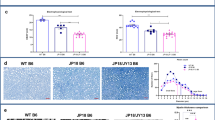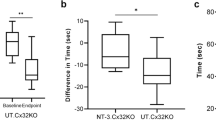Abstract
Charcot-Marie-Tooth disease (CMT) is the most common hereditary peripheral neuropathy, affecting 1 in 2,500 people. The only treatment currently available is rehabilitation or corrective surgery. The most frequent form of the disease, CMT-1A, involves abnormal myelination of the peripheral nerves. Here we used a mouse model of CMT-1A to test the ability of ascorbic acid, a known promoter of myelination, to correct the CMT-1A phenotype. Ascorbic acid treatment resulted in substantial amelioration of the CMT-1A phenotype, and reduced the expression of PMP22 to a level below what is necessary to induce the disease phenotype. As ascorbic acid has already been approved by the FDA for other clinical indications, it offers an immediate therapeutic possibility for patients with the disease.
This is a preview of subscription content, access via your institution
Access options
Subscribe to this journal
Receive 12 print issues and online access
$209.00 per year
only $17.42 per issue
Buy this article
- Purchase on Springer Link
- Instant access to full article PDF
Prices may be subject to local taxes which are calculated during checkout





Similar content being viewed by others
References
Dyck, P.J., Oviatt, K.F. & Lambert, E.H. Intensive evaluation of referred unclassified neuropathies yields improved diagnosis. Ann. Neurol. 10, 222–226 (1981).
Ouvrier, R.A. & Nicholson, G.A. Advances in the genetics of hereditary hypertrophic neuropathies in childhood. Brain Dev. 17, 31–38 (1995).
Skre, H. Genetic and clinical aspects of Charcot-Marie-Tooth disease. Clin. Genet. 6, 98–118 (1974).
Boerkoel, C.F. et al. CMT disease and related neuropathies: mutation distribution and genotype-phenotype correlation. Ann. Neurol. 51, 190–201 (2002).
Nelis, E. et al. (The European CMT Consortium). Estimation of the mutation frequencies in Charcot-Marie-Tooth disease type 1 and HNNP: a European collaborative study. Eur. J. Hum. Genet. 4, 25–33 (1997).
Lupski, J.R. et al. DNA duplication associated with Charcot-Marie-Tooth disease type 1A. Cell 66, 219–232 (1991).
Raeymaekers, P. et al. Duplication in chromosome 17p11.2 in Charcot-Marie-Tooth neuropathy type 1a (CMT 1a). Neuromuscul. Disord. 1, 93–97 (1991).
Matsunami, N. et al. Peripheral myelin protein-22 gene maps in the duplication in chromosome 17p11.2 associated with Charcot-Marie-Tooth disease type 1A. Nat. Genet. 1, 176–179 (1992).
Patel, P.I. et al. The gene for peripheral myelin protein PMP-22 is a candidate for Charcot-Marie-Tooth disease type 1A. Nat. Genet. 1, 159–165 (1992).
Timmerman, V. et al. The peripheral myelin protein gene PMP-22 is contained within the Charcot-Marie-Tooth disease type 1A duplication. Nat. Genet. 1, 171–175 (1992).
Valentijn, L.J. et al. The peripheral myelin protein gene PMP-22/GAS-3 is duplicated in Charcot-Marie-Tooth disease type 1A. Nat. Genet. 1, 166–170 (1992).
Roa, B.B. et al. Charcot-Marie-Tooth disease type 1A: association with a spontaneous point mutation in the PMP 22 gene. N. Engl. J. Med. 329, 96–101 (1993).
Valentijn, L.J. et al. Identical point mutations of PMP-22 in Trembler-J mouse and Charcot-Marie-Tooth disease type 1A. Nat. Genet. 2, 288–291 (1992).
Fenton C.F., Schlefman, B.S. & McGlamry, E.D. Surgical considerations in the presence of Charcot-Marie-Tooth disease. J. Am. Podiatr. Assoc. 74, 490–498 (1984).
Gould, N. Surgery in advanced Charcot-Marie-Tooth disease. Foot Ankle 4, 267–273 (1984).
Njegovan, M.E., Leonard, E.I. & Joseph, F.B. Rehabilitation medicine approach to Charcot-Marie-Tooth disease. Clin. Podiatr. Med. Surg. 14, 99–116 (1997).
Huxley, C. et al. Construction of a mouse model of Charcot-Marie-Tooth disease type 1A by pronuclear injection of human YAC DNA. Hum. Mol. Genet. 5, 563–569 (1996).
Huxley, C. et al. Correlation between varying levels of PMP22 expression and the degree of demyelination and reduction in nerve conduction velocity in transgenic mice. Hum. Mol. Genet. 7, 449–458 (1998).
Carey, D.J. & Todd, M.S. Schwann cell myelination in a chemically defined medium: demonstration of a requirement for additives that promote Schwann cell extracellular matrix formation. Brain Res. 429, 95–102 (1987).
Eldridge, C.F. et al. Differentiation of axon-related Schwann cells in vitro. I. Ascorbic acid regulates basal lamina assembly and myelin formation. J. Cell. Biol. 105, 1023–1034 (1987).
Plant, G.W. et al. Purified adult ensheathing glia fail to myelinate axons under culture conditions that enable Schwann cells to form myelin. J. Neurosci. 22, 6083–6091 (2002).
Hood, J. Femoral neuropathy in scurvy. N. Engl. J. Med. 281, 1292–1293 (1969).
Norreel, J.C. et al. Behavioural profiling of a murine Charcot-Marie-Tooth disease type 1A model. Eur. J. Neurosci. 13, 1625–1634 (2001).
Chapillon, P. et al. Early development of synchronized walking on the rotarod in rats. Effects of training and handling. Behav. Brain Res. 93, 77–81 (1998).
Garcia, C.A. A clinical review of Charcot-Marie-Tooth disease. Ann. NY Acad. Sci. 883, 69–76 (1999).
Carter, R.J. et al. Characterization of progressive motor deficits in mice transgenic for the human Huntington's disease mutation. J. Neurosci. 19, 3248–3257 (1999).
Sancho, S. et al. Distal axonopathy in peripheral nerves of PMP22 mutant mice. Brain 122, 1563–1577 (1999).
Coschigano, K.T. et al. Deletions, but not antagonism, of the mouse growth hormone receptor results in severely decreased body weights, insulin, and insulin-like growth factor I levels and increased life span. Endocrinology 144, 3799–3804 (2003).
Sabéran-Djoneidi, D. et al. Molecular dissection of the Schwann cell specific promoter of the PMP22 gene. Gene 248, 223–231 (2000).
Agus, D.B. et al. Vitamin C crosses the blood-brain barrier in the oxidized form through the glucose transporters. J. Clin. Invest. 100, 2842–2848 (1997).
Nishikawa, Y. et al. Vitamin C metabolomic mapping in experimental diabetes with 6-DFA and high resolution 19F magnetic resonance spectroscopy. Metabolism 6, 760–770 (2003).
Lopez-Lluch, G. et al. Redox regulation of cAMP levels by ascorbate in 1,25-dihydroxy-vitamin D3-induced differentiation of HL-60 cells. Biochem. J. 331, 21–27 (1998).
Yang, Z., Copolov, D.L. & Lim, A.T. Ascorbic acid augments the adenylate cyclase-cAMP system-mediated POMC mRNA expression and β-endorphin secretion from hypothalamic neurons in culture. Brain Res. 706, 243–248 (1996).
Arrigoni, O. & De Tullio, M.C. Ascorbic acid: much more than just an antioxidant. Biochim. Biophys. Acta 1569, 1–9 (2002).
Rodriguez-Melendez, R. Importance of water-soluble vitamins as regulatory factors of genetic expression. Rev. Invest. Clin. 54, 77–83 (2002).
Acknowledgements
V.S. was a fellow of the Association Française contre les Myopathies (AFM), and P.N.-F. received support from the American Charcot-Marie-Tooth Association. This work was supported by an AFM grant. We thank CMT France for their constant support; L. Colleaux, N. Levy, M. Mitchell, F. Thomas and L. Villard for their critical reading of the manuscript; and UMAGT and A. Margotat for technical help with the real-time PCR experiments.
Author information
Authors and Affiliations
Corresponding author
Ethics declarations
Competing interests
A patent was deposited July 2002, approved in France (PCT in progress), by Université de la Méditerranée, INSERM and AFM. E.P., V.S., J.C.N. and M.F. are the discoverers.
Rights and permissions
About this article
Cite this article
Passage, E., Norreel, J., Noack-Fraissignes, P. et al. Ascorbic acid treatment corrects the phenotype of a mouse model of Charcot-Marie-Tooth disease. Nat Med 10, 396–401 (2004). https://doi.org/10.1038/nm1023
Received:
Accepted:
Published:
Issue Date:
DOI: https://doi.org/10.1038/nm1023
This article is cited by
-
HDAC3 Inhibition Stimulates Myelination in a CMT1A Mouse Model
Molecular Neurobiology (2022)
-
Treatment with IFB-088 Improves Neuropathy in CMT1A and CMT1B Mice
Molecular Neurobiology (2022)
-
Mechanisms and Treatments in Demyelinating CMT
Neurotherapeutics (2021)
-
Vitamin C deficiency mimicking inflammatory bone disease of the hand
Pediatric Rheumatology (2020)
-
Roles of vitamins in stem cells
Cellular and Molecular Life Sciences (2020)



